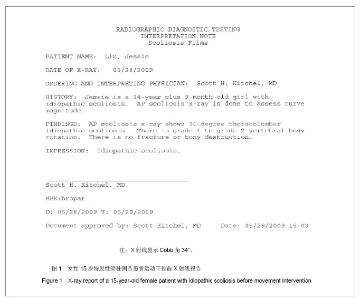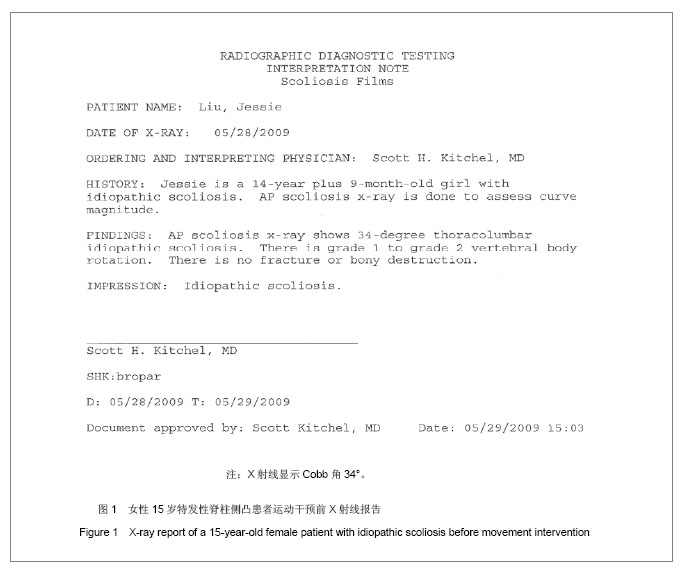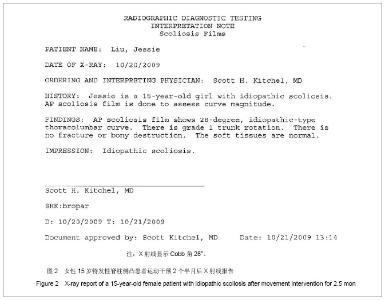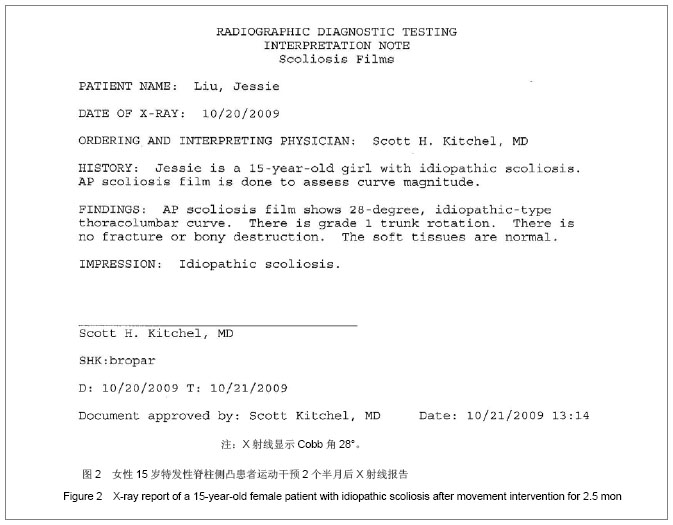| [1]Ye QB.Zhongguo Jiaoxing Waike Zazhi. 2009;17(19): 1444-1446.叶启彬.青少年脊柱侧弯矫正的进展[J].中国矫形外科杂志, 2009,17(19):1444-1446.[2]Cobb JR.Outlines for the study of scoliosis measurements from spinal roentgenograms. Physical Therapy.1948;59: 764-765. [3]Li JX,Sun DY.Beijing:People’s Medical Publishing House. 1993:78-79.李景学,孙鼎元.骨关节X线诊断学[M].北京:人民卫生出版社, 1993:78-79.[4]Tian HZ,Qu L,Lu X,et al.Zhongguo Jiaoxing Waike Zazhi. 2006;14(13):969-971.田慧中,曲龙,吕霞,等.牵拉成骨技术在发育期间脊柱畸形中的应用[J].中国矫形外科杂志,2006,14(13):969-971.[5]Pan SC.Zhonghua Xiaoer Waike Zazhi.2004;25(5):391.潘少川.对我国小儿脊柱外科发展的体会和企盼[J].中华小儿外科杂志, 2004,25(5):391.[6]Xiao JD,Xiong JY,Fan JJ,et al.Zhongguo Jiaoxing Waike Zazhi. 2001;8(12):1172–1174.肖建德,熊建义,范佳进,等.Cheneau支具治疗青少年特发性脊柱侧凸[J].中国矫形外科杂志,2001,8(12):1172-1174.[7]Bao YF,Qiu Y,Zhu LH,et al.Zhongguo Jizhu Jisui Zazhi. 2001;11(4):201-203.包岳丰,邱勇,朱丽华,等.Milwaukee支具治疗青少年特发性脊柱侧凸的疗效分析与应用体会 [J].中国脊柱脊髓杂志,2001,11(4): 201-203.[8]Wang S,Chen ZP,Ying H,et al.Zhongguo Linchuang Kangfu. 2002;6(20):3045.王隼,陈祖平,应灏,等.Boston’s支具治疗青少年特发性脊柱侧凸[J].中国临床康复,2002,6(20):3045.[9]Chen LD,Chen HQ,Ao RL,et al.Zhongwai Yixue Yanjiu. 2012; 10(22):135-136.陈理端,陈环球,敖瑞苓,等.支具治疗青少年特发性脊柱侧凸的疗效分析[J].中外医学研究,2012,10(22):135-136.[10]Zhang XY,Wang KL,Zhang LH,et al. 2012;20(8):711-713,768.张秀英,王克来,张连海,等.矫形支具在先天性脊柱侧凸治疗中的应用[J].中国矫形外科杂志,2012,20(8):711-713,768.[11]Zhou HQ,Zhang JX,Lin SS,et al.Zhongguo Zhongyi Gushangke Zazhi. 2012;20(1):32-33.周惠清,张建新,林思舜,等.不同性别对青少年特发性脊柱侧凸患者支具治疗生存质量评价的影响[J].中国中医骨伤科杂志,2012, 20(1):32-33. [12]Tao YP,Wu JG,Ma SH,et al.Zhongguo Jiaoxing Waike Zazhi. 2011’19 (23):1947-1949,1953.陶有平,吴继功,马华松,等. 支具治疗对青少年特发性脊柱侧凸近期肺功能的影响[J]. 中国矫形外科杂志,2011,19 (23):1947- 1949,1953.[13]Tao YP,Wu JG,Ma HS,et al.Zhongguo Jiaoxing Waike Zazhi. 2011’19(1):43-45.陶有平,吴继功,马华松,等.支具治疗青少年特发性脊柱侧凸的研究进展[J].中国矫形外科杂志,2011,19(1):43-45. [14]Tao YP,Wu JG,Ma HS.Zhongguo Jizhu Jisui Zazhi. 2011’21(9): 778-779. 陶有平,吴继功,马华松.支具治疗对青少年特发性脊柱侧凸患者生活质量影响的研究进展[J].中国脊柱脊髓杂志,2011, 21(9): 778-779. [15]Yu B,Wang YP,Qiu GX,et al.Zhongguo Jizhu Jisui Zazhi. 2011; 21(9):731-735.于斌,王以朋,邱贵兴,等.支具治疗对女性青少年特发性脊柱侧凸患者肺功能的影响[J].中国脊柱脊髓杂志,2011,21(9): 731-735. [16]Liu W,Chen QH,Wang L,et al.Zhongguo Jiaoxing Waike Zazhi. 2011;19(15):1244-1247.刘巍,陈庆贺,王仑,等.哈尔滨市青少年脊柱侧凸普查与支具治疗结果分析[J].中国矫形外科杂志,2011,19(15):1244-1247.[17]Goldberg CJ, Dowling FE, Hall JE,et al.A statistical comparison between natura lhistory of idiopathic scoliosis and brace treatment in skeletally immature adolescent girls. Spine. 1993;18 :902-908.[18]Wong MS, LeeJ T, Luk KD, et al. Effectof different casting methods on adolescent idiopathic scoliosis. Prosthet Orthot Int.2003;27 :121-131. [19]Lonstein JE,Winter RB.The Milwaukee brace for the treatment of adolescent idiopathic scoliosis. A review of one thousand and twenty patients. J Bone Joint Surg Am.1994; 76 :1207-1221.[20]Noonan KJ , Weinstein SL ,Jacobson WC, et al. Use of the Milwaukee brace for progressive idiopathic scoliosis. J Bone JointSurg Am.1996;78:557-567.[21]Matsunaga S, Hayashi K, Naruo T, et al. Psychologic management of brace therapy for patients with idiopathic scoliosis. Spine.2005;30:547-550.[22]Freidel K, Reichel D, Steiner A, et al.Idiopathic scoliosis and quality of life. Stud Health Technol Inform. 2002; 88:24-29.[23]Andersen MO, Andersen GR, Thomsen K, et al. Early weaning might reduce the psychological strain of Boston bracing:A study of 136 patients with adolescent idiopathic scoliosis at 3.5 years after termination of brace treatment. J Pediatr OrthopB.2002;11:96-99.[24]Lou E, Raso JV , Hill DL, et al. Correla tion between quantity and qualityof orthosis wear and treatment outcomesin adolescent idiopathic scoliosis. Prosthet OrthotInt. 2004;28 :49-54.[25]Lu HR,Ma RF,Ding Y,et al.Yishi Jinxiu Zazhi. 2005;28(10): 56-58.吕浩然,马若凡,丁悦,等.脊柱侧弯的研究和治疗现状[J].医师进修杂志,2005,28(10):56-58. [26]Shands AR,Barr JS,Colonna PC,et al.End-result study of the treatment of idiopathic scoliosis. Journal of Bone & Joint Surgery.1941;(23): 963-977.[27]Stone B,Beekman C,Hall V,et al. The effect of an exercise program on change in curve in adolescents with minimal idio- pathic scoliosis, a preliminary study. Physical Therapy. 1979;(6): 759-763.[28]Weiss HR, Weiss G, Petermann F. Incidence of curvature progression in idiopathic scoliosis patients treated with scoliosis in-patient rehabilitation (SIR): an age- and sex-matched controlled study. Pediatric Rehabilitation. 2003;6(1):23-30.[29]Yamada K, Yamamoto H, Nakagawa Y,et al. Etiology of idiopathic scoliosis. Clin Orthop.1998;357(184):50-57.[30]Keessen W, Crowe A, Hearn M.Proprioceptive accuracy in idiopathic scoliosis.Spine.1997;17(2):149-155.[31]Richard A. Magill. Motor Learning And Control (Seven Edition). Mc Graw High Education.1992.[32]Anne Shumway-Cook, Marjorie H. Woollacott. Motor Control:theory and practical applications. Williams & Wilkins, 1995:157.[33]Voss D, Ionata M, Myers B. Proprioceptive neuromuscular facilitation: patterns and techniques, 3rd ed. Philadephia: Harper & Row.1985.[34]Giuliani CA. Dorsal rhizotomy for children with cerebral palsy: Support for concepts of motor control. Phys Ther 1991: 71(3): 248-259. |



